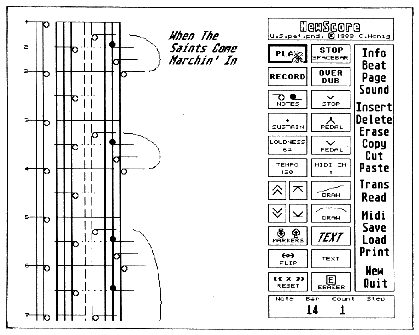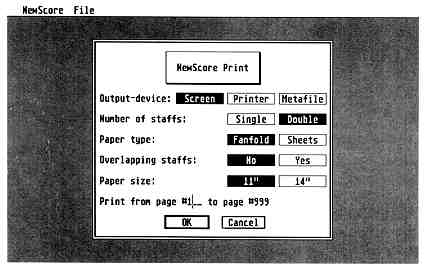Challenge Tradition With Newscore
A Fast Track to Reading and Playing Music?
BY JIM PIERSON-PERRY
START CONTRIBUTING EDITOR
Learning to read music notation is one of the hardest tasks for budding musicians. Whether you play a grand piano, saxophone or just sing in the choir, there is no escaping it. Unfortunately, many people become frustrated trying to relate the abstract notation symbols from sheet music to the physical keys on their instruments.
Newscore is an integrated sequencer/scoring program based on an alternative music notation system developed in the Netherlands. it uses a piano roll format where the notes to be played are shown on a representation of piano keys. The direct visual mapping of notation to instrument makes it easy to start playing music.
What's the Score?
The basis of the Newscore notation system is to show notes by their
positions on a color-coded piano keyboard. The stem direction, left or
right, denotes which hand is to play the note. All notes in a chord lie
on a single stem. Once played, a note is held down until the next note
for that hand comes along or a "stop" symbol (rest) appears. This makes
note duration a function of the distance between successive notes on the
score rather than an intrinsic note property as in standard notation.
The staff is a generalized keyboard with vertical lines representing black keys. Middle C is highlighted by adjacent dashed lines to orient the score. The score itself is read from top to bottom and divided into equally spaced regions called bars- the equivalent of measures in standard notation. Each bar is subdivided into beats that mark the rhythm. All notes are placed on a beat.

Main working screen for the Newscore
program. The
actual score takes up the majority
of the screen with the
operations toolbox to the right. The
music is read like a
piano roll, from top to bottom, on
a staff that represents
a piano keyboard.

The dialog box from the printing module
of the Newscore
program. Options are screen preview,
save score to a
GEM metafile (and import into other
graphics programs
for additional enhancements) or printout.
Additional markings denote sustain pedal, staccato notes and note sustain. Some familiar symbols have been kept from standard notation to express slurs, trills, loudness, repeats, etc.
Program Overview
The Newscore program lets you enter music from a MIDI keyboard or with
the mouse. You can then quickly see it displayed onscreen in the new notation.
The score can be edited, enhanced with text and graphics and printed on
an Epson-compatible dot matrix or Atari SLM804 laser printer. The program
functions on two levels. As an educational tool, it provides a rapid feedback
system to learn the notation and start reading music. It can also be used
as a simple sequencer just to play music and have fun.
auxiliary program
enables color
monitors to emulate
high resolution.
The main program contains the sequencer module. Score printing is done by an independent program that can be run as a stand-alone application or internally through the sequencer. New-score runs on all ST/Mega models and is not copy-protected. It was written in GFA BASIC and requires GDOS (supplied on the program disk for printouts). Newscore was designed for a monochrome monitor, but an auxiliary program is provided that enables color monitors to emulate high resolution. Desk accessories cannot be accessed in the main program but are available through the printing module.
A brief manual attempts to summarize both the Newscore notation system and program operation. Fortunately, the program is intuitive enough to use on its own, since the manual is sketchy about most operations and would greatly benefit from a tutorial and screen shots. The MIDI set-up section also contains an error regarding use of a master keyboard with slave synthesizer. If set up as written, it will only work if the master has internal MIDI merging (not typical) and the slave has MIDI Thru (which the Casio CZ-101, for example, doesn't).
Making Music
The sequencer module is the engine of the program. Music data can be
captured from a MIDI keyboard or entered on the screen staff by placing
notes with the mouse. The only MIDI events recorded are MIDI channel, note
pitch, note-on velocity and the sustain pedal controller. No other controllers,
program changes or sysex data are saved. All data goes into a single track,
the initial recording as well as any later overdubs.
MIDI Thru is supported, without rechanneling, but the implementation is flawed. When recording or overdubbing, the Thru operates only for MIDI channel 1. Even if you're entering notes with the mouse, you will not hear them unless MIDI Thru is set to MIDI channel 1. The actual notes, however, are captured correctly and played on the designated channels during playback. Overdubbing a note with the same note on a different MIDI channel erases the original one; this precludes voice doubling.
The reset command is only partially operative. It's supposed to send an "all notes off" message but only works occasionally and then just for MIDI channel 1.
To add notes to the screen staff with the mouse, you left-click to place them and right-click to erase them. Their velocity and MIDI channel can be set and altered using screen numerical controls. The sustain pedal controller can be turned on or off throughout the staff; alternatively, single notes can be marked to sustain on an independent basis using a sustain symbol. Notes can only be entered in step-time with the mouse. If you use a MIDI keyboard to enter music, you must record in real time-at least the tempo can be set low to relax the time pressure.
Music data can be played back either through MIDI or the ST's three internal sound voices (monitor speaker), but not both at once. The program does not support internal sound voices created by the G.I.S.T. program.
The playback tempo can be set at any value from 40 to 240 beats per minute, but the tempo cannot be varied during playback. The sequencer internal timing resolution is 96 pulses per quarter note, more than adequate for most needs. It has no problems reproducing triplets, 64th notes or grace notes on playback. The program does not send clock data, nor can it synch to an external source, thus limiting its use with a drum machine.
Edit Audit
Once music data has been entered into Newscore, there's virtually no
way to change it at the individual note level, short of deleting and re-entering
it. Only sustain and attack (staccato) can be modified. No controls are
provided over the sequencer quantizing operation, precluding easy correction
of timing errors. A transpose command can be used to shift the entire song,
or a marked portion of it, up or down by up to 12 semitones regardless
of MIDI channel.
Moving up to a regional level of editing opens a few more options. Sections of a staff can be cut or copied and pasted, much like a word processor. The mouse is dragged along the staff to define the desired region, anywhere from a single beat to the entire song. A similar approach can be used to define a region for deleting groups of notes. Sections can be deleted or space can be opened up in the staff to insert new notes. Once started, all of these operations can only be canceled by clicking the right mouse button -an important fact that was omitted from the manual. Any other keyboard input triggers the edit action, and there is no Undo function.
Several means are provided to move quickly through the screen staff display. Cursor buttons let you jump to the start or end, or advance up or down by one screen length. Moving the mouse pointer to the top or bottom of the screen scrolls the display. You can also use the mouse to adjust the bar counter to a desired destination-press [Return] and the display jumps to it. In general, screen movement is fast and smooth. Only with staffs containing slurs or lines does scrolling slow down noticeably.
saved as a GEM
metafile and
imported into
desktop publishing
programs.
Song playback normally begins from bar 1 and continues to the end, but markers can be placed to change the start and stop bar boundaries. The marked-off region can be as little as one beat. The playback bar counter shows elapsed bars from the start marker rather than the actual bar number which can be confusing. The markers also can be used to delimit the transposition function-handy if you just want to change the key for part of a song.
One weakness of the program becomes painfully obvious during editing. Whenever you make any change, there is a time lag between clicking the playback button and when the music starts. For a test song with 60 bars of music, adding just one note with the mouse caused a 45-second delay. Deleting a single note took another 60 seconds. Any change to the staff causes the delay- even just adding text and not changing any note at all. It gets worse as the number of changes increases; adding or deleting just three notes sent the delay up to 90 seconds. Even using markers to restrict the playback region to just a single beat, it still took 12 seconds to hear the results of adding one note.
Enhancements and Output
Several graphics tools are provided to enhance the appearance of your
score, including drawing lines and slurs (curved lines) and placing text
anywhere on the screen. Two sizes of text are supplied as GDOS fonts, one
suitable for titles and the other for fingering or performance notes.
The score can be saved as a GEM metafile and imported into other applications programs for additional graphics modifications or desktop publishing. Newscore can also read song files in standard MIDI file format (level 0). This lets you import songs created with other sequencers and see them under the Newscore notation system.
Printer drivers are supplied for Epson-compatible 9- and 24-pin printers and the Atari SLM804 laser printer. Output can be previewed on-screen before committing to hardcopy. Even on a 9-pin dot matrix printer, the output quality is good.
Conclusions
The Newscore notation system is described as a new approach to reading
music that lets you start playing tunes in minutes. My experience has been
that this is indeed the case. Both my 6-and 8-year-old children were able
to sit down at the piano and easily pick out tunes written in this format.
Benefits of this system for non-keyboard instruments are less obvious.
More problematical is the program's description of being the "ultimate music language and sequencer" Musical pedagogy aside, it is clearly inadequate as a sequencer compared to other commercial or even public domain programs. Particularly painful is the claim of unrivaled speed in view of the gross delays in auditing editing changes.
Even given that the program is intended primarily as a musical education program and not as a dedicated sequencer, Newscore earns a cautious recommendation. The underlying principle is good: Newscore notation can provide a quick route to reading and performing music. To achieve any degree of acceptance, however, the program must be fixed to improve editing, allow step entry from a MIDI keyboard, correct the MIDI Thru problems and increase execution speed. The developer is aware of these concerns and is addressing them immediately. With these improvements, Newscore could be just the ticket to open up the world of music to those still waiting at the door.
START Contributing Editor Jim Pierson-Perry is a research chemist and semiprofessional musician living in Elkton, Maryland.
PRODUCTS MENTIONED
Newscore version 1.01, $99. Newscore, Inc., 200 South Tryon Street,
Charlotte, NC 28202, (704) 376-3085.
CIRCLE 150 ON READER SERVICE CARD